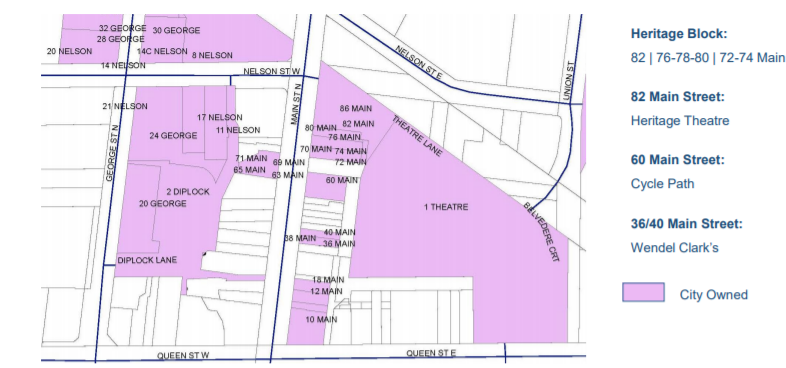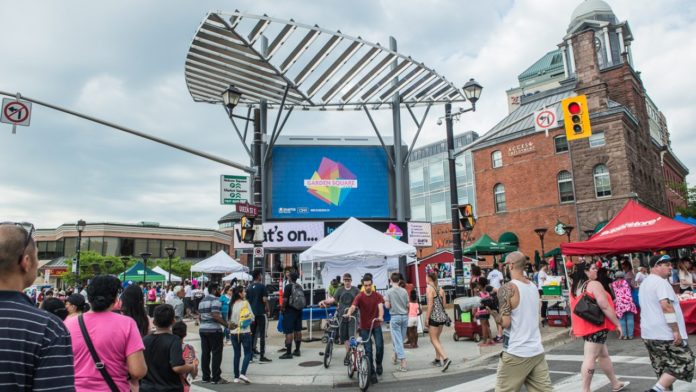Staff reveal that former Brampton City Council tried to push the Downtown Revitalization Project with a blank cheque in order to protect their LRT location.
.
May 11, 2021 (4 Minute Read)
In a stunning revelation, the Acting Commissioner for Public Works, Jayne Holmes, provided context to City Councillors last week regarding the downtown streetscaping project. The admission was focused on what was formerly called the Downtown Revitalization project and the impact this project would have on determining where to locate the Light Rail Transit (LRT).
City Council voted to tender the Downtown Revitalization project, 4 months before the election, in order to thwart any change in direction imposed by a newly elected Council. They wanted the tender to be awarded by September 2018, even though there was no associated costs or budget identified. With the tender awarded, there would be legal obstacles and substantial expenses for any new Council to cancel the project.
Why would this occur? To dictate the location of the Light Rail Transit (LRT)…more on this later.
Downtown Revitalization Project (Now called Downtown Reimagined)
In May 2018, 4 months prior to the next municipal election, City Council voted to proceed with the tender of the Downtown Revitalization project. The project consisted of:
- Replacement and relining the existing aging sanitary sewers;
- Installation of new watermains and sanitary and storm sewers and other utilities to accommodate future growth; and
- Construction of new streetscaping (new paving stones, trees and lighting).
According to staff, the tender for the Downtown Reimagined project was rushed.
Last week, at a public Council workshop, Commissioner Holmes explained, “Just to review where we were a few years ago, when we were going out for tender for Downtown Reimagined, we were on a very tight timeline. And there were some aspects of the project that were unknown at the time, or we would find out as we were going along. And because of the request to get the tender out, when we were asked to do so, there were limited opportunities to investigate some of the things we were finding out”.
The Commissioner was referring to the location of the utilities (especially the sewer and water mains) and the abandoned channel of Etobicoke Creek (located directly underneath of several downtown buildings).
As a result, staff engineers were recommending against awarding the tender for the project due to the many unknowns, which would create unidentifiable project costs and liabilities. For example, during replacement of the utilities, would the buildings collapse due to deteriorating infrastructure and the abandoned waterway underneath?
Regardless of the concerns, the former City Council directed staff to proceed with the tender in hopes of awarding the contract by September 2018. This would then handcuff the newly elected Council to honour the binding contractual agreement. If Council were to cancel the contract, they would face millions of dollars in lawsuits. Fortunately, the issuance of the tender was delayed due to the complexity of the project.
The 2018 municipal election occurred in October, and a new Council was immediately forced to consider the tender results.
If we did award, I was going to be asking council to commit to a cost that i was not able to tell you what it was
“As we advised…Council took our recommendation that we do not award (the tender), because again if we did award, I was going to be asking for Council to commit to a cost that I was not able to tell you what it was”, said Commissioner Holmes, “So that did not seem like a good way to manage public funds, to award a tender when you weren’t sure what the costs was going to be”.
Mayor Brown then asked, “Why was there pressure on the timeline of the tender?”
Commissioner Holmes responded, “My direction at the time was to ensure that tender was awarded prior to the election”, and stated that, “We had some certainty on two things, the alignment of the LRT which was not going through the downtown at the time, and the certainty of the university”.
“Once you award a tender, you are in a legal position, where you should proceed with that tender. If you try and undo it after you awarded, you would be putting yourself into a situation where you would have legal obligations towards the contractor. If there was going to be some change in thought, for instance on the university or on the LRT, with the new Council, then we would be in a precarious position as it relates to that tender”.
Mayor Brown then concluded, “It sounds like there was direction given to rush out a tender to meet a political timetable, that essentially was an attempt to tie this Council’s hands-on having a discussion on issues like where the LRT goes. It was unfortunate that staff was put in that position, and because the public did not have the context of all this information. One, that this Council was put on their lap, essentially being told you have to write a blank cheque when we don’t know what the cost is going to be. No responsible business, no responsible Board of Directors, would approve a blank cheque. And secondly being told at the same time, that there could be significant legal liabilities for the City because buildings could cave in”.
Councillor Rowena Santos told the Bramptonist, “Details are finally becoming transparent regarding political pressure used in the previous term, to push projects like Downtown Reimagined without proper due diligence. Decisions were made despite warnings of potential safety risks and liabilities. Unfortunately, this precarious situation fell on the laps of the new term of Council within the first month of our tenure. We chose to do the right thing and paused the project in order to ensure the safety of residents and businesses in the downtown. This is just one example of poorly made decisions that we have had to deal with; politically motivated decisions made by members who have since retired.”
The Downtown Revitalization project would have torn up the streets for 3 years for millions of unknown dollars and liabilities. And, the streets would have to be torn up again, if the LRT was selected to be along downtown Main Street, thereby wasting tens of millions of dollars.
The impact on local businesses would be devastating. Rip open the streets for streetscaping, then, ripping the streets open again for the LRT.
.
How Many Properties Did the City Buy and At What Cost?
Brampton Councillor Pat Fortini jumped into the discussion by asking staff, “Did we purchase the whole block?”
Staff then referred to the diagram below:

“We were put under pressure”, explains Councillor Fortini, “Those channels (Etobicoke Creek) like Mayor Brown explained, a lot of people knew they were there.”
Now, many of the businesses are gone, and the City owned properties sit empty.
For the businesses that remained, Fortini reported he has received many calls from them inquiring about the Region’s construction plan to replace the utilities (water and sewer mains). And if the utilities are replaced, what happens when new public transit infrastructure is installed, do they need to be replaced again?
According to Commissioner Holmes, the proposed sewer and watermain replacement by the Region is a $7-8 million “temporary” fix. So yes, another disruption to the downtown core.
It is no wonder former Council members, who were not re-elected, are trying everything possible to distract the new Council from making informed decisions. They are trying to cover their decision-making process and the millions of taxpayers’ dollars spent and wasted.
It is time, based on the political timeline created by the former Council, that the whole project be investigated. For example, it needs to be determined how much taxpayers’ funds were used to proceed with a political agenda, where the former Council ignored the recommendations of staff.
And there needs to be questions asked on the negative impacts experienced by the downtown businesses, the ones who remained, and the ones that have since closed due to the inept decisions of the former Council.















